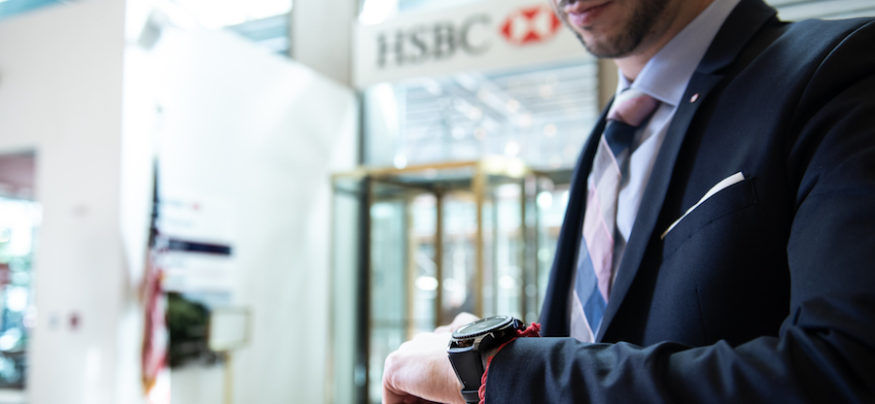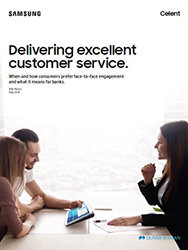HSBC advanced the frontier of retail banking innovation in 2018 with a new smartwatch pilot program at its flagship branch in Manhattan.
The bank equipped a dozen bank associates and the branch manager with Samsung Gear S3 smartwatches in a leading-edge pilot program to examine how mobile technology can improve retail bank operations and customer experience.
The pilot outfitted the staff and managers with smartwatches designed to streamline communication, provide more efficient customer service and assist the branch manager in tracking overall bank operations across all three floors of HSBC’s 5th Avenue branch in Manhattan. HSBC and Samsung launched the pilot with the hope of laying a path for rollouts at HSBC branches around the world.
This new approach to in-store bank technology was made possible by advances in the software and security enabled by the Gear S3 smartwatch, which offers the performance, functionality and enterprise-grade security needed to operate in a banking environment. Each smartwatch worn by bank employees was specifically configured to feature an HSBC enterprise application, and the devices were operated in a lockdown mode to restrict functionality exclusively to the enterprise app driving this transformation of retail banking operations.
According to Samsung and HSBC, this pilot served two important use cases: customer experience from the moment the customer walks through the branch’s front doors, and branch manager communications with staff members in the branch.
Providing responsive, efficient customer service
The impact of the Gear S3 smartwatch was evident from the moment customers walked into the front door of an HSBC branch. Upon entering, they were greeted by an employee who asked them how they would like to be helped that day. By using preset messages built into the smartwatch app, the team member at the front desk was able to send an instant alert to the branch associate who could best address the customer’s request. The associate could use their watch to reply immediately, indicating whether or not they could accept the task requested at that time.
Creating Personalized Customer Experiences
Get your free guide to when, how and why consumers want face-to-face interaction with their banks. Download Now
The ability to quickly connect consumers with banking specialists was a critical component of leveraging mobility in retail banking. Smartphones may be the go-to device for performing simple transactions and views, but according to a banking customer survey commissioned by Samsung, Celent found 77 percent of consumers still prefer face-to-face interaction when handling more complex banking tasks. And while it is an in-person experience they seek at the branch, they also want the bank to embrace innovative technology such as smartwatches. HSBC asked the branch team to discuss the smartwatches as they used them, so customers would be aware that the bank was innovating on their behalf.
Once the smartwatch pilot launched in September 2017, HSBC observed improvements to the wait time and response time for customers walking into the smartwatch-equipped branch. These are two of the most important metrics when evaluating customer service and customer satisfaction in brick-and-mortar retail banks. HSBC planned to evaluate the pilot in terms of technical feasibility, user adoption and changes in wait time and response time.
A tool for better branch management
While bank employees provided better service at the first point of contact with customers, the branch’s network of interconnected smartwatches offered significant value to the branch manager role. With staff spread throughout three stories of retail space, and with the branch manager constantly on the move, the smartwatch provided vital communications support. Associates could ping the branch manager when they needed support such as an override. The manager could also initiate communication to an individual employee or to the whole branch team.
In a large branch like HSBC’s 5th Avenue location, tracking down the branch manager can often be a time-consuming process, because the manager is often on the go. The longer it takes to enlist the help of the manager, the greater the potential impact on the customer experience. The smartwatches enabled real-time communication that minimized wait times and helped the branch manager respond quickly to the staff’s needs.
The watches used the LTE network for both data and voice communications, and employees could call each other with their watches. Data on the device was secured with Samsung Knox security.
HSBC’s smartwatch pilot illustrated the instant impact mobile technologies can offer to the customer experience in retail banks. The retail bank remains an important destination for consumers, and mobile innovation is the key to providing better customer service and retaining those customers for years to come.
Learn how to develop new and innovative wearable apps tailored precisely to your business needs. Or, learn exactly what consumers are looking for when they arrive to the bank branch — and how mobile-equipped associates can help.









